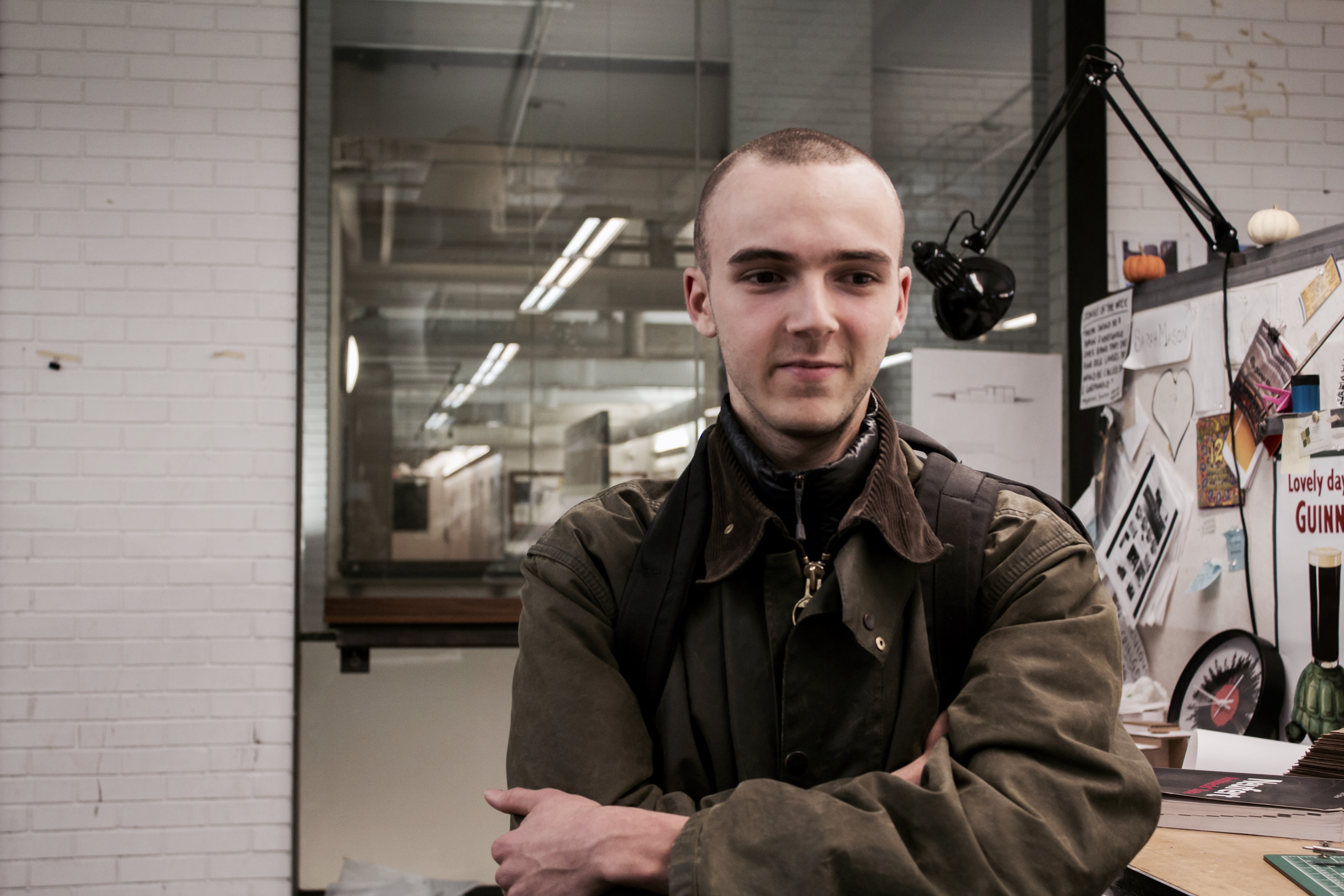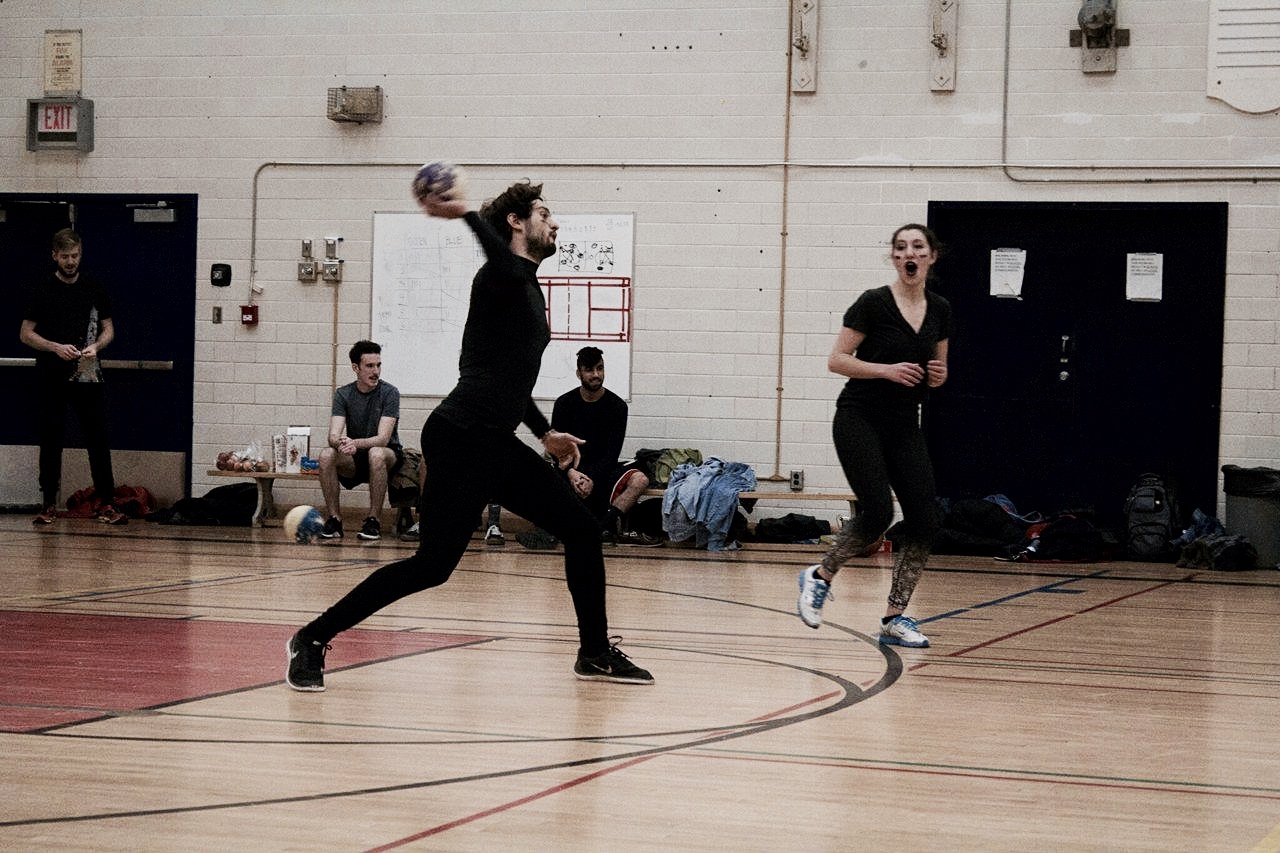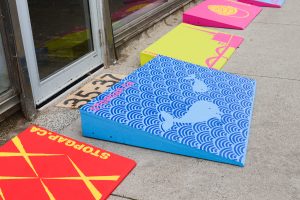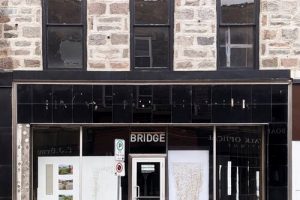
“I’d always painted before school, and for my interview to get into Waterloo actually, I brought in some of my paintings. There’s something very cool about doing something with your hands, there’s a freedom that I feel gets lost a lot from projects that we do at school sometimes. The focus is on the technology — sometimes you might find that when you’re designing something in your head, you’re limiting yourself to what Rhino can do, what you can CNC, what you can make a model of, because you have to do these things. I find that’s so limiting, because it takes away the artist in you, in a way. As an artist, in order to produce something that’s expressive, you have to be completely free — I think painting and sculpting does that. That’s why I’d like to focus on finding a bridge between the two — I do find technology very beneficial, but sometimes it can be very limiting. I felt the most free in first year, I think, with us not being allowed to use computers, I found a lot of freedom in all the models that I made and designed. That changed once the technology was introduced. But then in 4B, I got to a point where I got very comfortable with all the computer stuff, and I was able to bring back some of the hand-made stuff. I was encouraged to show both aspects of design, the hand and the computer aspects. It took me a few years to figure that out. If I could go back to my first year self, I’d tell myself: ‘hold on to that desire to produce things by hand, to be expressive and free. You’re going to be introduced to all these things that are new that you’re going to take a few years to just kind of get used to, but in the end, trust that it’ll all come together and produce something that’s cooler than both separately.”

What’s a childhood memory that you hold really close to you?
“When I first came to Canada when I was five, we didn’t really have anybody or any connection to here besides my uncle and his place in Montreal. I remember it was the coolest loft ever, with the coolest parties — he even had a lava lamp. It was so surreal and just crazy, and I think it actually inspires my take on architecture today, and it was also an introduction to Canada, to this whole new world, coming from Bulgaria. I remember the first day of Kindergarten, I didn’t understand what anyone was saying, I was just so confused and felt completely lost. I don’t actually remember when I started feeling comfortable with english, it just kind of happened gradually. It just hit me one day, thinking ‘what the hell, I actually know what everyone’s saying?’ The first move to a new country is always hard, right? I’m glad I came when I was a kid, because then people don’t really judge you, like in high school and middle school. I mean, it was tough at first, but now I feel I’m fitting in really well. I definitely feel less connected to my roots now, though. In Montreal, I was surrounded by such a big Bulgarian community, I had so many friends that were Bulgarian — my connection to the culture was a lot stronger there than when we moved to Ottawa. I try to keep it up, though — talking to my parents more often, reading in Bulgarian, watching Bulgarian movies and TV shows as much as I can, but I’ve lost a lot of it for sure throughout my time in Canada. It’s really cool when I go back to visit though, because it brings me back to my childhood. Even if I feel like I’ve lost it, it’s always in me, it’s always been a part of me. But I definitely don’t feel like I fit in there anymore–it’s changed a lot. The lifestyle, the mentality and everything is so different from those here. We have different values, perspectives, priorities and possibilities. It makes it hard to relate to some friends I still have there. I still have a connection with them though, even if we don’t talk all the time. We were babies together, we made home videos together, we played in backyards together. I do think about this all the time though — what would my life be like now if I were still there?”

What’s a memory that inspires you?
“I feel like this past summer, even if it’s super recent, is definitely something that affects me the most now. It was really cool, being able to live in Japan for four months. I’d never been there for that long, even with half of my family being there. Being there for an extended period of time made me realize how much more I fit in there than I’d thought. At first it was challenging, but eventually I felt really at home there — I was able to appreciate so much more about that country. I think that when I’ve felt super challenged or felt down this term, I just think about how hard it was, how challenging it was at certain times. It was really hard — the job was really hard, there was a lot of culture shock, but I was eventually able to settle into that environment and really appreciate it for what it is. I lived in Tokyo while I was there, and it was really amazing to see that in such a congested place, there are still so many moments where people can create beautiful spaces. That’s what I really liked the most about living there — I was continuously really surprised by how I would just stumble upon these places in between so many things that were happening. That was really inspiring for me, especially in terms of architecture, that this city with so much pollution and density is still able to function in a way where people can still have these really nice moments. Architecture is so important over there, to an extreme degree, in relation to here. In Tokyo, you’re designing for all the most extreme conditions. Not just natural disasters, but site conditions as well. Even in the most cramped spaces, there would be family houses where so many people have to share a bedroom — the architect’s job is to still create those nice moments through beautiful spaces.”

What’s your favourite childhood memory?
“One time, I was playing hockey in Europe — we were representing ‘Team Canada’, and we were playing a Swiss team in the semi-finals. We lost to them, but we became very good friends with them afterwards. We started talking with them, hanging out after the game. We decided, instead of getting on the bus and heading back to our hotel because we had a flight out somewhere else the next day, we stuck around and we stayed late. We cheered them on for the final game. The whole time, we were banging against the boards, going crazy, cheering them on. They were one goal down, with 5 minutes left to go. They then ended up tying the game, then winning. We all poured over the boards, they took off their jerseys and threw em to us in the crowd, and we just all came together and celebrated their championship on the ice with them. It was just the most amazing thing — half of these guys didn’t even speak english, and we were just uniting for this one thing, this one moment. It was so incredible, every time I think about it, it gives me chills. You don’t become that close with people so quick, normally. It was overseas, we couldn’t even talk to them, but there was something about us that just made a really strong and immediate connection. We were able to just celebrate with the opposing team, which isn’t something you usually get to do. It was just all around a good time. I think it reflects what I find important in life, maybe. These really precious connections, little moments, these untainted relationships with people that are just pure and from the heart. It doesn’t happen often, but things like sports are able to bring that out in people. Certain circumstances allow for these really beautiful and true connections to be made.”

What’s it been like to adjust to life in Canada over the years after moving from Korea?
“It actually wasn’t that hard for me, because I was so young — I came here when I was six, in grade 1. It’s funny, when I first came to Canada, my mom dyed my hair blonde so I would fit in better. When you’re a kid, you don’t really have a sense of race, so they thought I was actually one of them, they thought I was caucasian. I was not very good at korean either, so adjusting to english was no big deal. Where I grew up in the town I was in, there weren’t that many asian kids. My parents purposefully moved to where there wasn’t that much influence from immigrants yet because they wanted me to learn english. Things got a lot better when I made my first friend. This girl just gestured at me on the playground to push her down the slide, and we just went for like 30 minutes, just pushing each other down the slide. It was actually the best moment ever. I miss being a kid. When you’re a kid, you don’t care about anything, you can make friends so easily, even just by going ‘let’s have a snack!’ While doing co-op especially, being out in the world, you just definitely don’t feel like a kid anymore. I’m not looking forward to being out of university and having all these responsibilities. A lot of successful people actually still have ‘the mind of a kid’. While growing up, you start adding all these limitations to yourself and your creativity, a box that you create to have to fit into. But as a kid, you don’t really know any limitations, you don’t know what can and can’t be. You just make what ever you believe is possible.”

What’s something that encourages you to keep pushing yourself, especially when times get tough here?
“This is going to sound cheesy…but for me, it’s about humanity in general. I feel I have a responsibility, a motive to want to help people in a certain way. I want to make something different. It’s not about my mark — it’s about making other people’s lives better. It’s not about me. Everything I think about, or do, is about the other. ‘A lot of people need help, and what is it that you’re going to do about it?’ That’s something I think about a lot. For me, what I do is about change, about the betterment of human condition. Advocacy through architecture, environmentalism — those things are how I see myself doing something about it. I’ve always been into questioning, asking why people are suffering. The more I learn about stories of war, oppression and suffering, the more urgency I feel to do something that might empower the people. That’s why I like the idea of political empowerment, people controlling their own lives. ‘Stick it to the Man’, you know? But on a global scale. As a kid, I moved around a lot. Every four years, we moved to a new place, a new country. When you move that much as a kid, you feel your place in the world a lot earlier on. The more you travel, the more you learn how big the world is. I was born in Syria, when I was four we moved to Saudi Arabia because of economic conditions, and when I was seven, we moved to Canada where we got citizenship three years later. I’d pretty much forgotten all my arabic by that time — I was pretty young when we moved. I also didn’t know any english at all, so I had to learn that. Then, when I was ten, we moved to Oman, where I basically relearned arabic — basically from ESL in Canada to ASL. Then, in tenth grade, we moved back to Canada. It’s not the best situation to grow up in — every time you move, the new place feels shitty, you miss the old place and just want to go back, you feel like everybody there sucks. Nothing felt permanent. You learn to not get too attached to anything. I do have attachment to some things though, like Damascus — I was born there, half of my family is there, and every few summers we’d go to visit. It was one of the few consistencies in my life.”

Who would you consider your role model?
“I do have an older sister. I was talking to a friend the other day about lightheartedness in architecture, and that sometimes people just feel the need to be serious in architecture school because they feel that if they’re too lighthearted, or make jokes or smile too much, then they won’t be seen as a serious student. I kind of think that that’s true, that people sometimes try to suppress their warmer and lighter side in order to seem more serious. My sister, she’s a very very serious and hard worker, but she’s never had to sacrifice her warmth in order to do that. She’s studying to be a psychiatrist, in her final year of residency. She’s just worked incredibly hard to get through medical school. Whenever I’d complain to her about architecture school, she’d go ‘oh, that sounds really hard, I totally sympathize with you.’ Meanwhile, she was working harder, pulling 80 hour weeks, actually doing critical work — as a medical student, you do various rotations. You have to do a surgery rotation, a psychiatry rotation, an internal medicine rotation. Long weeks, not a lot of sleep and actually working with her hands for people’s lives. All through this, she never lost her sense of humour. Every time I’ve talked to her on the phone, she’d always make jokes to make me feel better — she’s probably the most compassionate person I know. She’s my goal post for where I want to be in eight years. My earliest memories of her are her as a teenager. In order to be a compassionate person, I think, you have to not be self-conscious. Teenagers tend to be very self-conscious, they feel like the world is watching them, when really, no one is watching you since everyone is absorbed in their own problems. I think you grow out of that once you pass through your early twenties. She learned that there are bigger problems than her own sense of insecurity, so her compassion grew, turning into her passion towards helping other people.”

Your first year here is almost over — what’s your impression of the place so far? Anything you’re planning to carry with you for future terms?
“Well, yeah — coming up with your concept before you start designing. So far I’ve come up with the parti after a week of concept-less design, and you realize you kind of just wasted that week. Hopefully, I’ll be able to figure stuff out in terms of time management. I guess it’s weird because with art, there’s nothing practical about it. You can kind of conceptually make it all about your own experience. That’s the purpose of art, to impose your own personal experience on an object. But it’s kind of stupid to do that in building. I mean, other people will be the ones experiencing it, so to kind of impose your own experience on other people is kind of weird. You’re less attached to what you make in architecture, it’s less personal. You can get attached to an idea, sure, but you don’t really impose yourself onto it, where the building is a reflection of your personality like an artwork. What I like about architecture is that it can be very rational — what they kind of seem to encourage is to make it very rational. I don’t think it necessarily needs to be that way, but it seems like they’re basing the quality of the project on the concept and how resolved it is. Just this morning, I found an artist/architect who works completely different from the the way we’re encouraged here. So I know it doesn’t have to be a certain way — you can draw some random scribbles and make that your building, your floor plan. But this school, it’s a lot less weird that I thought it would be. Not so many weird people — I expected to see more people interested in ‘weird’ stuff. It feels similar to my high school. They all seem relatively normal. Once we’re in the environment long enough though, I think we’ll all get a bit more weird. It’s definitely more fun here than my high school — I enjoy all the work I do here. Being able to just figure things out for yourself, I think, makes the work more bearable. It’s more rewarding.”
BEHIND THE CAMERA…

“If you know me, then you know that I tend to work non-stop, crash from exhaustion, then go back to doing the exact same thing like nothing ever happened.”

“There are times when I get so happy about something, I don’t know what to do with myself. One time, I got so excited to go see a movie that I’d been waiting forever to come out, that I got sick from getting a fever from being so hyped up about it. It sucked then, since I was forced to miss the premiere because I got sick — but it was pretty awesome to know that I can get that excited about something.”

(BONUS PIC): Architecture students do dodgeball!!
Third year architecture student at the University of Waterloo School of Architecture.
~Plenty o' joy, a dollop of dork and a little hint of madness.





Leave a Reply